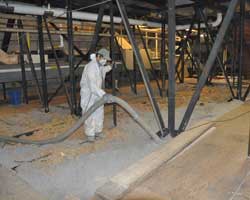Full Circle—A Smith
Recycling Story

A 12-inch-thick layer of cellulose insulation
was recently applied to the floor of the Neilson Library attic. |
From Smith to Belchertown and back to Smith.
That was the path recently taken by hundreds of unread
newspapers that had been delivered to Smith. The newspapers, left unclaimed on campus
stands, were delivered, via paper recycling brokers, to a company called National
Fiber, an insulation manufacturer in nearby Belchertown, Mass.
A few weeks ago, those newspapers came back to campus
in the form of cellulose insulation when a company named Celluspray, which purchases
its product from National Fiber, applied a 12-inch-thick layer of the material in
the Neilson Library attic.
“This is sustainability in action,” said
Dano Weisbord, environmental sustainability director. “We improved the efficiency
of Neilson by using a product made from a waste stream. As a result of this project,
Smith will consume less fuel, emit less carbon, and save money.”
The ceiling above the 1936 addition to Neilson Library
was full of holes into the attic as a result of renovations and systems upgrades
over the years, said project manager Gary Hartwell. Spanning a space of about 6,500
square feet, the attic had had a layer of loose fiberglass insulation, originally
about 6 inches thick. But as a result of decades of projects and service, the insulation
was matted and full of holes, or missing altogether.
The holes were allowing conditioned air to escape into
the unheated and uncooled attic. Celluspray filled the holes before installing the
cellulose insulation.
The cellulose insulation made with discarded newspapers
and other materials is a superior product to fiberglass, noted Hartwell. It is a
denser material, and fills voids more efficiently. Furthermore, he added, “fiberglass
takes a lot more energy to produce, is not a recycled product, and is an irritant.”
Everyone wins in this recycling story, said Weisbord. “We’ve
saved energy, supported a local business and helped divert materials from the landfill.
It doesn’t get much better than that.” |























